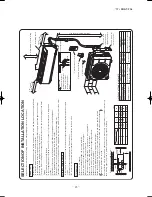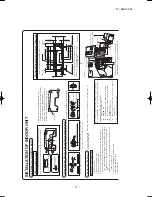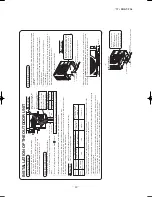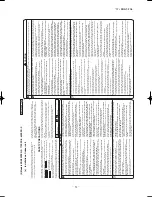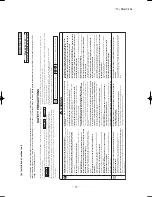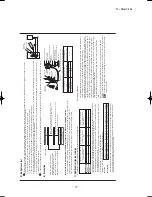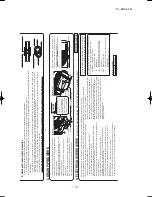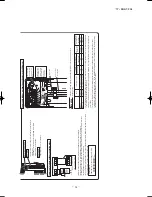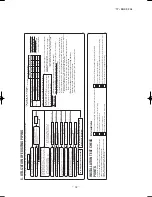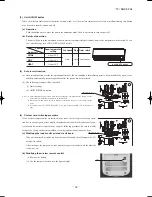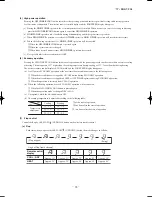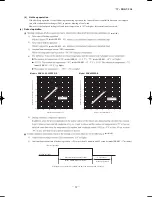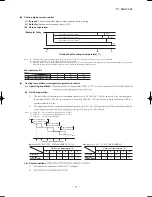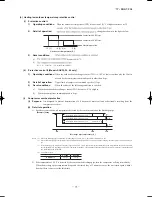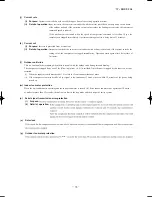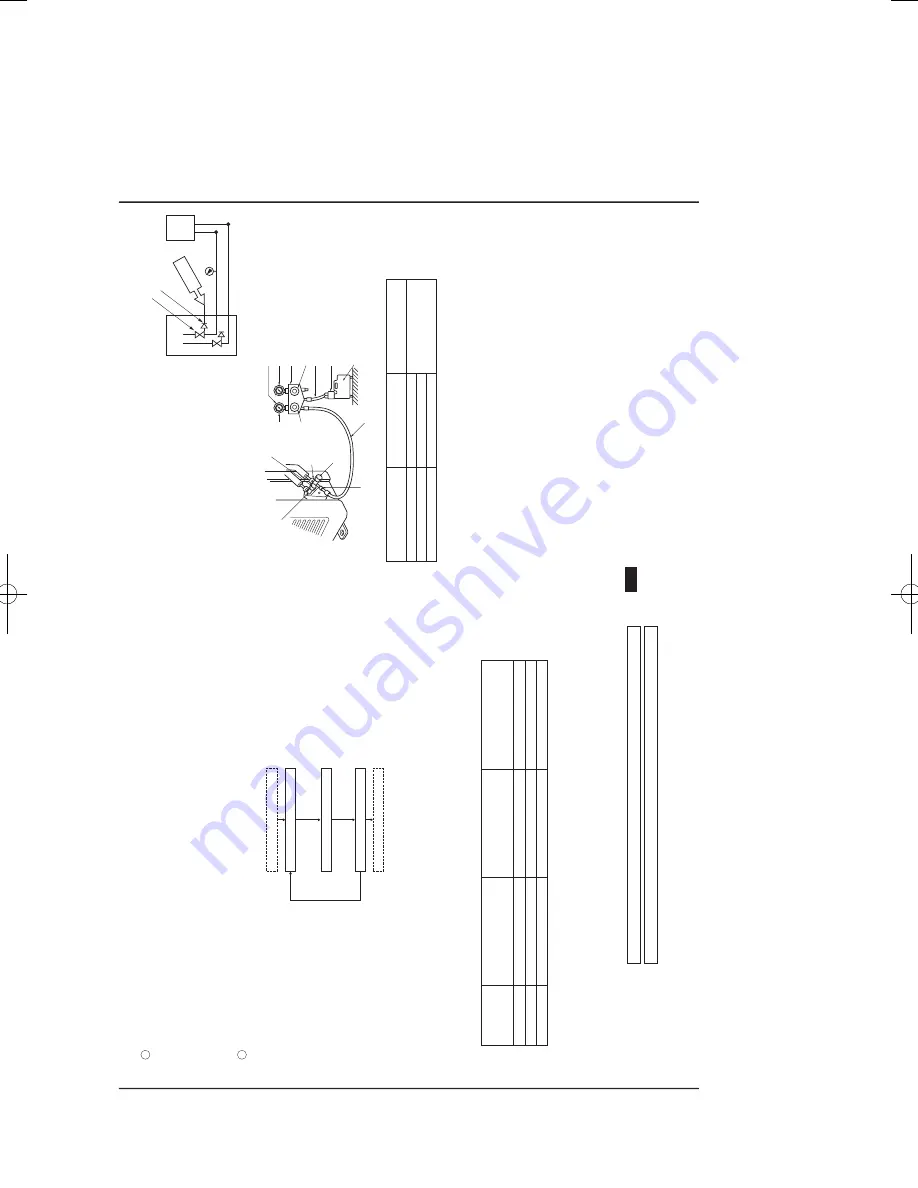
-
-
'17 • SRK-T-206
Wires for connecting indoor and outdoor units
Exterior tape
Gas piping
Insulation
Liquid piping
Band (procured locally)
Pipe cover (procured locally)
8) Heating and condensation prevention
Take
care
so
that
installed
pipes
may
not
touch
components
within
a
unit.
If
pipes
touch
internal
components,
abnormal
sounds
and/or
vibrations.
4) On-site piping work
IMPORTANT
How to remove the side cover
Remove
the
screw
of
the
side
cover
and
remove
to
the
front.
A
B
Flared
pipe
end
:
A
(mm)
ø6.35
ø12.7
ø15.88
Copper
pipe
outer diameter
0 A –04
9.1
16.6
19.7
ø6.35
ø12.7
ø15.88
Copper
pipe
outer diameter
0
-
0.5
1.
0
-
1.5
Copper
pipe
protrusion
for
flaring
:
B
(mm)
In
the
case
of
a
rigid
(clutch)
type
With
an
R410A
tool
With
a
conventional
tool
CAUTION
Do
not
apply
force
beyond
proper
fastening
torque
in
tightening
the
flare
nut.
Tightening angle (
°
)
Tightening torque (N·m)
ø6.35 (1/4")
ø12.7 (1/2")
ø15.88 (5/8")
Recommended length of a tool handle (mm)
Service valve size (mm)
5) Air tightness test
Gas side service valve
Check joint
Pressurize
Close
Outdoor unit
Indoor unit
<Work flow>
6) Evacuation
Pay attention to the following points in addition to the above for the R410A and compatible machines.
Air tightness test completed
Fill refrigerant
Vacuum gauge check
Vacuuming completed
Vacuuming begins
3)
Refrigerant
pipe
wall
thickness
and
material
NOTE
*Phosphorus deoxidized seamless copper pipe ICS 23.040.15, ICS 77.150.30
ø6.35
0.8
O-type pipe
ø12.7
0.8
O-type pipe
ø15.88
1.0
O-type pipe
Pipe diameter [mm]
Minimum pipe wall thickness [mm]
Pipe material*
UÊ
-iiVÌÊ
ÀivÀ}iÀ>ÌÊ
««iÃÊ
vÊ
Ì iÊ
Ì>LiÊ
à ÜÊ
Ê
Ì iÊ
À} ÌÊ
Ü>Ê
Ì ViÃÃÊ
>`Ê
>ÌiÀ>Ê
>ÃÊ
ëiVvi`Ê
for
each
pipe
size.
Although outdoor and indoor units themselves have been tested for air tightness at the factory, check the connecting pipes afte
r the installation work for air tightness from the service valve’s
check joint equipped on the outdoor unit side. While conducting a test, keep the service valve shut all the time. a)
Raise
the
pressure
to
0.5MPa,
and
then
stop.
Leave
it
for
five
minutes
to
see
if
the
pressure
drops.
b)
Then
raise
the
pressure
to
1.5MPa,
and
stop.
Leave
it
for
five
more
minutes
to
see
if
the
pressure
drops.
c)
Then
raise
the
pressure
to
the
specified
level
(4.15MPa),
and
record
the
ambient
temperature
and
the
pressure.
d)
If
no
pressure
drop
is
observed
with
an
installation
pressurized
to
the
specified
level
and
left
for
about
one
day,
it
is
acceptable.
When
the
ambient
temperature
fall
1
C,
the
pressure
also
fall
approximately
0.01MPa.
The
pressure,
if
changed,
should
be
compensated
for.
e)
If
a
pressure
drop
is
observed
in
checking
e)
and
a)
–
d),
a
leak
exists
somewhere.
Find
a
leak
by
applying
bubble
test
liquid
to
welded
parts
and
flare
joints
and
repair
it.
After
repair,
conduct
an
air
tightness
test
again.
In
conducting
an
air
tightness
test,
use
nitrogen
gas
and
pressurize
the
system
with
nitrogen
gas
from
the
gas
side.
Do
not
use
a
medium
other
than
nitrogen
gas
under
any
circumstances.
UÊ
>ÀÀÞÊ
ÕÌÊ
Ì iÊ
Ê
ÃÌiÊ
««}Ê
ÜÀÊ
ÜÌ Ê
Ì iÊ
ÃiÀÛViÊ
Û>ÛiÊ
vÕÞÊ
VÃi`°
UÊ
ÛiÊ
ÃÕvvViÌÊ
«ÀÌiVÌÊ
ÌÊ
>Ê
««iÊ
i`Ê
V«ÀiÃÃi`Ê
>`Ê
L>âi`]Ê
ÀÊ
ÜÌ Ê
>Ê
adhesive
tape)
so
that
water
or
foreign
matters
may
not
enter
the
piping.
UÊ
i`Ê
>Ê
««iÊ
ÌÊ
>Ê
À>`ÕÃÊ
>ÃÊ
>À}iÊ
>ÃÊ
«À>VÌV>Ê
,£ä
0-
R150).
Do
not
bend
a
pipe
repeatedly
to
correct
its
form.
UÊ
>ÀiÊ
ViVÌÊ
ÃÊ
ÕÃi`Ê
LiÌÜiiÊ
Ì iÊ
ÕÌÊ
>`Ê
ÀivÀ}iÀ>ÌÊ
««i°Ê
>ÀiÊ
>Ê
««iÊ
>vÌiÀÊ
engaging
a
flare
nut
onto
it.
Flare
dimensions
for
R410A
are
different
from
those
for
conventional
R407C.
Although
we
recommend
the
use
of
flaring
tools
designed
specifically
for
R410A,
conventional
flaring
tools
can
also
be
used
by
adjusting
the
measurement
of
protrusion
B
with
a
protrusion
control
gauge.
UÊ
/ iÊ
««iÊ
à Õ`Ê
LiÊ
>V Ài`Ê
iÛiÀÞÊ
£°xÊ
ÀÊ
iÃÃÊ
ÌÊ
Ã>ÌiÊ
Ì iÊ
ÛLÀ>Ì°Ê
UÊ
/} ÌiÊ
Ì iÊ
v>ÀiÊ
ÌÊ
ÃiVÕÀiÞÊ
ÜÌ Ê
>Ê
`ÕLiÊ
ë>iÀ°Ê
UÊ
/Ê
«ÀiÛiÌÊ
>Ê
`vviÀiÌÊ
Ê
vÀÊ
iÌiÀ}]Ê
ÕÃiÊ
`i`V>Ìi`Ê
ÌÃ]Ê
iÌV°Ê
ÌÊ
i>V Ê
ÀivÀ}iÀ>ÌÊ
ÌÞ«i°Ê
1`iÀÊ
Ê
VÀVÕÃÌ>ViÃÊ
ÕÃÌÊ
a
gauge
manifold
and
a
charge
hose
in
particular
be
shared
with
other
refrigerant
types
(R22,
R407C,
etc.).
UÊ
1ÃiÊ
>Ê
VÕÌiÀvÜÊ
«ÀiÛiÌÊ
>`>«ÌiÀÊ
ÌÊ
«ÀiÛiÌÊ
Û>VÕÕÊ
«Õ«Ê
Ê
vÀÊ
iÌiÀ}Ê
Ì iÊ
ÀivÀ}iÀ>ÌÊ
ÃÞÃÌi°
UÊ
/ ÃÊÕÌÊVÌ>ÃÊv>VÌÀÞÊV >À}i`ÊÀivÀ}iÀ>ÌÊVÛiÀ
}Ê£xÊvÊÀivÀ}iÀ>ÌÊ««}Ê>`Ê>``Ì>ÊÀivÀ}iÀ>ÌÊV >À}i
ÊÊ
the installation site is not required for an installation with up to 15m refrigerant piping.
When refrigerant piping exceeds 15m, additionally charge an amount calculated from the pipe length and the above table for the portion in excess of 15m.
UÊ
vÊ>ÊiÝÃÌ}Ê««iÊÃÞÃÌiÊÃÊÕÃi`]ÊÀiµÕÀi`ÊÀivÀ}iÀ>ÌÊV >À}i
ÊÛÕiÊÜÊÛ>ÀÞÊ`i«i`}ÊÊÌ iʵÕ`Ê««iÊÃâi°ÊÀÊ
vÕÀÌ iÀÊvÀ>Ì]ÊÃiiʺx°Ê1/</" Ê"Ê8-/ Ê** °»
* When an additional charge volume calculation result is negative, it is not necessary to charge refrigerant additionally.
UÊ
ÀÊ>ÊÃÌ>>ÌÊi>ÃÕÀ}Ê£xÊÀÊÃ ÀÌiÀÊÊ««iÊi}Ì ]ÊV
>À}iÊÌ iÊÀivÀ}iÀ>ÌÊÛÕiÊV >À}i`ÊvÀÊÃ «iÌÊ>ÌÊ
the factory, when you recharge refrigerant after servicing etc.
Fix both liquid and gas service valves at the valve main bodies as illustrated on the right, and then fasten them, applying appropriate fastening torque.
Select
pipes
having
a
wall
thickness
larger
than
the
specified
minimum
pipe
thickness.
14
-
18
49
-
61
68
-
82
45
-
60
30
-
45
15
-
20
150
250
300
1
2
Run the vacuum pump for at least one hour after the vacuum gauge shows –0.1MPa or lower. (–76cmHg or lower)
When
the
system
has
remaining
moisture
inside
or
a
leaky
point,
the
vacuum
gauge
indicator
will
rise.
Check
the
system
for
a
leaky
point
and
then
draw
air
to
create
a
vacuum
again.
Confirm that the vacuum gauge indicator does not rise even if the system is left for one hour or more.
(Gas side)
Charge hose (Designed specifically for R410A)
Compound pressure gauge
Pressure gauge
Gauge manifold (Designed specifically for R410A)
Handle Hi
Vacuum pump
Vacuum pump adapter (Anti-reverse flow type) (Designed specifically for R410A)
Charge hose (Designed specifically for R410A)
Check joint
-0.1MPa
(-76cmHg)
H
an
dl
e
Lo
Service valve
Service valve
(Liquid side)
Service valve cap
Service valve cap
Service valve cap tightening torque (N·m)
Check joint blind nut tightening torque (N·m)
ø6.35 (1/4")
ø12.7 (1/2")
ø15.88 (5/8")
20
-
30
25
-
35
30
-
40
10
-
12
Service valve size
(mm)
Securely tighten the service valve cap and the check joint blind nut after adjustment.
(1)
Dress refrigerant pipes (both gas and liquid pipes) for heat insulation and prevention of dew condensation.
UÊ
«À«iÀÊ
i>ÌÊ
ÃÕ>ÌÉ>Ì`iÜÊ
`ÀiÃÃ}Ê
V>Ê
ÀiÃÕÌÊ
Ê
>Ê
Ü>ÌiÀÊ
i>Ê
ÀÊ
`À««}Ê
V>ÕÃ}Ê
`>>}iÊ
ÌÊ
ÕÃi `Ê
ivviVÌÃ]Ê
iÌV°
Ó®Ê
1ÃiÊ>Ê i>ÌÊÃÕ>Ì}Ê>ÌiÀ>ÊÌ >ÌÊV>ÊÜÌ ÃÌ>`Ê£Óä
℃
or a higher temperature. Poor heat insulating capacity can cause heat insulation problems or cable
deterioration.
UÊ
Ê
}>ÃÊ
««iÃÊ
ÕÃÌÊ
LiÊ
ÃiVÕÀiÞÊ
i>ÌÊ
ÃÕ>Ìi`Ê
Ê
À`iÀÊ
ÌÊ
«ÀiÛiÌÊ
`>>}iÊ
vÀÊ
`À««}Ê
Ü>ÌiÀÊ
Ì >ÌÊ
ViÃÊ
vÀÊ
Ì iÊ
V`iÃ>ÌÊ
vÀi`Ê
Ê
Ì iÊ
`ÕÀ}Ê
>Ê
V}Ê
operation
or
personal
injury
from
burns
because
their
surface
can
reach
quite
a
high
temperature
due
to
discharged
gas
flowing
inside
during
a
heating
operation.
UÊ
7À>«Ê
`ÀÊ
ÕÌýÊ
v>ÀiÊ
ÌÃÊ
ÜÌ Ê
i>ÌÊ
ÃÕ>Ì}Ê
«>ÀÌÃÊ
««iÊ
VÛiÀ®Ê
vÀÊ
i>ÌÊ
ÃÕ>ÌÊ
LÌ Ê
}>ÃÊ
>`Ê
µÕ`Ê
««iî°
UÊ
ÛiÊ
i>ÌÊ
ÃÕ>ÌÊ
ÌÊ
LÌ Ê
}>ÃÊ
>`Ê
µÕ`Ê
Ã`iÊ
««iðÊ
Õ`iÊ
>Ê
i>ÌÊ
ÃÕ>Ì}Ê
>ÌiÀ>Ê
>`Ê
>Ê
««iÊ
Ì} ÌÞÊ
Ì}iÌ iÀÊ
ÃÊ
Ì >ÌÊ
Ê
}>«ÃÊ
>ÞÊ
LiÊ
ivÌÊ
LiÌÜiiÊ
Ì iÊ
>`Ê
wrap
them
together
with
a
connecting
cable
by
a
dressing
tape.
UÊ
Both
gas
and
liquid
pipes
need
to
be
dressed
with
20mm
or
thicker
heat
insulation
materials
above
the
ceiling
where
relative
humidity
exceeds
70%.
(1)
Calculate a required refrigerant charge volume from the following table.
Formula to calculate the volume of additional refrigerant required
7) Additional refrigerant charge
Additional charge volume (g) = { Main length (m) – Factory charged volume 15 (m) } x 20 (g/m)
Model 63(21)
Additional charge volume (g) = { Main length (m) – Factory charged volume 15 (m) } x 25 (g/m)
Model 71(24), 80(28)
20
25
25
1.55
1.80
1.90
15
15
15
Model 63(21)
Model 71(24)
Model 80(28)
Put down the refrigerant volume calculated from the pipe length onto the caution label attached on the service panel.
UÊ
-ViÊ,{£äÊÀivÀ}iÀ>ÌÊÕÃÌÊLiÊV >À}i`ÊÊÌ iʵÕ`Ê« >Ãi]ÊÞ
ÕÊÃ Õ`ÊV >À}iÊÌÊii«}ÊÌ iÊVÌ>iÀÊ
cylinder upside down or using a refrigerant cylinder equipped with a siphon tube.
UÊ
>À}iÊÀivÀ}iÀ>ÌÊ>Ü>ÞÃÊvÀÊÌ iʵÕ`ÊÃ`iÊÃiÀÛViÊ«ÀÌÊÜ
Ì ÊÌ iÊÃiÀÛViÊÛ>ÛiÊÃ ÕÌ°Ê7 iÊÞÕÊv`ÊÌÊ
difficult to charge a required amount, fully open the outdoor unit valves on both liquid and gas sides and charge refrigerant from the gas (suction) side service port, while running the unit in the cooling mode. In doing so, care must be taken so that refrigerant may be discharged from the cylinder in the liquid phase all the time. When the cylinder valve is throttled down or a dedicated conversion tool to change liquid phase refrigerant into mist is used to protect the compressor, however, adjust charge conditions so that refrigerant will gasify upon entering the unit.
UÊ
ÊV >À}}ÊÀivÀ}iÀ>Ì]Ê>Ü>ÞÃÊV >À}iÊ>ÊV>VÕ>Ìi`ÊÛÕiÊLÞ
ÊÕÃ}Ê>ÊÃV>iÊÌÊi>ÃÕÀiÊÌ iÊV >À}iÊ
volume.
UÊ
7 iÊÀivÀ}iÀ>ÌÊÃÊV >À}i`ÊÜÌ ÊÌ iÊÕÌÊLi}ÊÀÕ]ÊV«iÌiÊ>
ÊV >À}iÊ«iÀ>ÌÊÜÌ ÊÎäÕÌið
Running the unit with an insufficient quantity of refrigerant for a long time can cause a compressor failure.
(2)
Charging refrigerant
NOTE
Additional charge volume (g) per meter of refrigerant piping
(liquid pipe ø6.35)
Refrigerant volume charged for shipment at the factory
(kg)
Installation’s pipe length (m) covered without additional refrigerant charge
The screw of the side cover is tightened securely.
Side
cover
Do not hold the valve cap area with a spanner.
RCR012A200C
4. ELECTRICAL WIRING WORK
For details of electrical cabling, refer to the indoor unit installation manual.
H 05 R N R 4or5 G
1.5
Harmonized cable type 300/500 volts Natural-and/or synth. rubber wire insulation Polychloroprene rubber conductors insulation Stranded core Number of conductors One conductor of the cable is the earth conductor (yellow/green) Section of copper wire (mm
2
)
H05RNR4G1.5 (Example) or 245IEC57
Electrical installation work must be performed by an electrical installation service provider qualified by a power provide
r of the country.
Electrical installation work must be executed according to the technical standards and other regulations applicable to electric
al installations in the country.
UÊ
ÊÌÊÕÃiÊ>ÞÊ«ÜiÀÊV>LiÊ} ÌiÀÊÌ >ÊiÊëiVvi`ÊÊ«>Ài
Ì iÃiÃÊvÀÊi>V ÊÌÞ«iÊLiÜ°
UÊ
LÀ>`i`ÊVÀ`ÊV`iÊ`iÃ}>ÌÊÈäÓ{xÊÊx£®
UÊ
À`>ÀÞÊÌÕ} ÊÀÕLLiÀÊÃ i>Ì i`ÊVÀ`ÊV`iÊ`iÃ}>Ì
ÊÈäÓ{xÊÊxή
UÊ
v>ÌÊÌÜÊÌÃiÊVÀ`ÊV`iÊ`iÃ}>ÌÊÈäÓÓÇÊÊ{£®
Ê
1ÃiÊ«ÞV À«ÀiiÊà i>Ì i`ÊviÝLiÊVÀ`ÊV`iÊ`iÃ}>Ì
ÊÈäÓ{xÊxÇ®ÊvÀÊ«ÜiÀÊ
cables of parts of appliances for outdoor use.
UÊ
ÀÕ`ÊÌ iÊÕÌ°ÊÊÌÊViVÌÊÌ iÊ}ÀÕ`}ÊÜÀiÊÌÊ>Ê}>ÃÊ«
«i]ÊÜ>ÌiÀÊ««i]Ê} Ì}ÊÀ`Ê
or telephone grounding wire.
If improperly grounded, an electric shock or malfunction may result.
UÊ
Ê}ÀÕ`}ÊÜÀiÊÕÃÌÊLiÊViVÌi`ÊLivÀiÊViVÌ}ÊÌ iÊ«Üi
ÀÊV>Li°Ê*ÀÛ`iÊ>Ê
grounding wire longer than the power cable.
UÊ
/ iÊÃÌ>>ÌÊvÊ>Ê«ÕÃiÊÜÌ ÃÌ>`}ÊÌÞ«iÊi>ÀÌ Êi>>}i
ÊLÀi>iÀÊÃÊiViÃÃ>ÀÞ°ÊÊÊÊÊÊÊÊÊÊÊ
A failure to install an earth leakage breaker can result in an accident such as an electric shock or a fire.
UÊ
ÊÌÊÌÕÀÊÊÌ iÊ«ÜiÀÊÕÌÊÌ iÊiiVÌÀV>ÊÜÀÊÃÊV«iÌi
`°
UÊ
ÊÌÊÕÃiÊ>ÊV`iÃÛiÊV>«>VÌÀÊvÀÊ«ÜiÀÊv>VÌÀÊ«ÀÛii
ÌÊÕ`iÀÊ>ÞÊVÀVÕÃÌ>ViðÊ
(It dose not improve power factor, while it can cause an abnormal overheat accident)
UÊ
ÀÊ«ÜiÀÊÃÕÀViÊV>LiÃ]ÊÕÃiÊV`ÕÌð
UÊ
ÊÌÊ>ÞÊiiVÌÀVÊVÌÀÊV>LiÃÊÀiÌiÊVÌÀÊ>`ÊÃ}>
}ÊÜÀiîÊ
and other cables together outside the unit. Laying them together can result in the malfunctioning or a failure of the unit due to electric noises.
UÊ
>ÃÌiÊÌ iÊV>LiÃÊÃÊÌ >ÌÊÌ ÃiÊ>ÞÊÌÊÌÕV ÊÌ iÊ««}]ÊiÌV°
UÊ
7 iÊV>LiÃÊ>ÀiÊViVÌi`]Ê>iÊÃÕÀiÊÌ >ÌÊ>ÊiiVÌÀV>ÊV
«iÌÃÊ
within the electrical component box are free of loose connector coupling or terminal connection and then attach the cover securely. (Improper cover attachment can result in malfunctioning or a failure of the unit, if water penetrates into the box.)
UÊ
iÛiÀÊÕÃiÊ>ÊÃ i`ÊV>Li°
UÊ
-,<,-]Ê8<,-Ê>`Ê-,9,-ÊV«iÃÊÜÌ ÊÌ iÊ,Ê i>`Ê,iëÃiÊ>L}ÊiÛViîÊÃÌ>`>À`Ê-É <-{Çxx°Î°£Ê>`Ê
supports demand response modes 1, 2, and 3 (DRM1, 2, and 3). Since the air-conditioner limits the electric power or energy by receiving the DRED input signal, the sense of cooling operation or heating operation may deteriorate over time. The outdoor unit of this air-conditioner is
CAUTION
Interconnecting and
grounding wires
(minimum)
Switch breaker
Over current protector
rated capacity
Power source
(minimum)
15A, 30mA, 0.1sec or less
20A, 30mA, 0.1sec or less
30A
30A
16A
20A
2.0mm
2
2.5mm
2
1.5mm
2
Ê8Ê{
1.5mm
2
Ê8Ê{
Earth leakage breaker
Phase
Single-phase
Single-phase
Model 63(21)
Model 71(24), 80(28)
UÊ
/ iÊëiVvV>ÌÃÊà ÜÊÊÌ iÊ>LÛiÊÌ>LiÊ>ÀiÊvÀÊÕÌÃÊÜ
Ì ÕÌÊ i>ÌiÀðÊÀÊÕÌÃÊÜÌ Ê i>ÌiÀÃ]ÊÀiviÀÊÌÊÌ iÊÃÌ>>Ì
Ê
instructions or the construction instructions of the indoor unit.
UÊ
-ÜÌV }i>ÀÊÀÊÀVÕÌÊLÀi>iÀÊV>«>VÌÞÊÜ V ÊÃÊV>VÕ>Ìi
`ÊvÀÊ>ÝÕÊÛiÀÊVÕÀÀiÌÊÃ Õ`ÊLiÊV ÃiÊ>}ÊÌ iÊ
regulations in each country.
UÊ
/ iÊV>LiÊëiVvV>ÌÃÊ>ÀiÊL>Ãi`ÊÊÌ iÊ>ÃÃÕ«ÌÊÌ >ÌÊ>Êi
Ì>ÊÀÊ«>ÃÌVÊV`ÕÌÊÃÊÕÃi`ÊÜÌ ÊÊÀiÊÌ >ÊÌ ÀiiÊV>LiÃÊ
contained in a conduit and a voltage drop is 2%. For an installation falling outside of these conditions, follow the internal cabling regulations. Adapt it to the regulation in effect in each country.
Switchgear or Circuit Breaker
Model SRC-ZR-S
Model SRC-ZRA-S, DXC-ZRA-S, SRC-YRA-S
<T
able of pipe size restrictions>
◎
: Standard pipe size
○
\Ê1Ã>LiÊÊÊ
△
: Restricted to shorter pipe length limits
Additional charge volume (g) = {Main pipe length (m)
-
Length covered without additional
V >À}iÊà ÜÊÊÌ iÊÌ>LiÊ®PÊ8Ê``Ì>ÊV >À}iÊÛÕiÊ
per meter of pipe shown in the table (g/m)
Formula to calculate additional charge volume
NO
Are the existing units our products?
NO
NO
NO
NO
NO
NO
Is the existing pipe system to reuse free of corrosion, flaws or dents?
Repair the damaged parts.
Remove those branches.
Repair the damaged parts.
Check the pipe system for air tightness on the site.
Repair the damaged parts.
No loose pipe supports
NO
9-
ST
AR
T
The existing pipe system is reusable.
The existing pipe system is not reusable. Install a new pipe system.
9-
9-
9-
9-
9-
Are an outdoor unit and an indoor unit connected to the existing pipe system to reuse?
Is the unit to install in the existing pipe system a twin-triple-double-twin model?
Is the existing pipe system to reuse free of gas leaks? (Check whether refrigerant charge was required frequently for the system before)
Are heat insulation materials of the existing pipe system to reuse free of peel-offs or deterioration? (Heat insulation is necessar
y for both gas and liquid pipes)
Change the branching pipe to a specified type.
Does the existing pipe system to reuse satisfy all of the following? (1) The pipe length is 30m or less. (2) The pipe size conforms to the table of pipe size restrictions. (3) The elevation difference between the indoor and outdoor units
conforms to the following restrictions.
Where the outdoor unit is above: 20m or less Where the outdoor unit is below: 20m or less
Which of the following refrigeration oils does the existing unit use? Suniso, MS, Barrel Freeze, HAB, Freol, ether oil, ester oil
Make an inquir
y
for reusability
.
Change
Change is impossible.
>Ê1Ãi
>ÊÌÊ1Ãi
Repair
is impossible.
Air tightness is impossible.
Remove is impossible.
Repair is impossible.
Repair
Repair
Repair
Some loose pipe supports
Air tightness is OK
Remove
Check whether an existing pipe system is reusable or not by using the following flow chart.
Are not there any loose pipe supports?
Are there any branch pipes with no indoor unit connected?
NO
※
If you obtain a negative figure as a result of calculation, no additional refrigerant needs to be charged.
Example)
When an SRC63 is installed in a 10m long existing pipe system (li
quid
ø
9.52,
gas
ø
12.7), the quantity of refrigerant to
charge additionally should be (10m
-
5m) x 60g/m
=
300g.
<Where the existing unit can be run for a cooling operation.>
Carr
y out the following steps with the excising unit
(in the order of (1), (2), (3) and (4))
(1) Run the unit for 30 minutes for a cooling operation. (2) Stop the indoor fan and run the unit for 3 minutes for a cooling operation (returning liquid) (3) Close the liquid side ser
vice valve of the outdoor unit and pump down (refrigerant recover
y)
(4) Blow with nitrogen gas.
※
If discolored refrigeration oil or any foreign matters is discharged by
the blow
, wash the pipe system or install a new pipe system.
UÊÀÊÌ iÊv>ÀiÊÕÌ]Ê`ÊÌÊÕÃiÊÌ iÊ`Êi]ÊLÕÌÊÕÃiÊÌ iÊiÊÃ
Õ««i`ÊÜÌ ÊÌ iÊÕÌ`ÀÊÕÌ°Ê
Process a flare to the dimensions specified for R410A.
<Where the existing unit cannot be run for a cooling operation.>
W
ash the pipe system or install a new pipe system.
UÊvÊÞÕÊV ÃiÊÌÊÜ>à ÊÌ iÊ««iÊÃÞÃÌi]ÊVÌ>VÌÊÕÀÊ`ÃÌÀ
LÕÌÀÊÊÌ iÊ>Ài>°
W
ARNING
※
Check with the flow chart developed for a case where an existing pipe system is reused for a twin-triple-double-twin model published as a technical data sheet.
Always use an earth leakage circuit breaker designed for inverter circuits to prevent a faulty operation.
1ÃiÊV>LiÃÊvÀÊÌiÀViVÌÊÜÀ}ÊÌÊ>Û`ÊÃi}ÊvÊÌ i
Ê
wires. CENELEC code for cables Required field cables.
In case of faulty wiring connection, indoor unit dose not operate. Then, run lamp turns on and timer lamp blinks.
INSTALLATION TEST CHECK POINTS
After installation
Power cables and connecting wires are securely fixed to the terminal block.
The power source voltage is correct as the rating.
The drain hose is fixed securely.
Service valve is fully open.
No gas leaks from the joints of the service valve.
The pipe joints for indoor and outdoor pipes have been insulated.
The reverse flow check cap is attached.
The cover of the pipe cover (A) faces downward to prevent rain from entering.
Gaps are properly sealed between the pipe covers (A) (B) and the wall surface / pipes.
The screw of the side cover is tightened securely.
Check the following points again after completion of the installation, and before turning on the power. Conduct a test run again and ensure that the unit operates properly. Explain to the customer how to use the unit and how to take care of the unit following the instruction manual.
5. UTILIZA
TION OF EXISTING PIPING
Main
fuse
specification
250V 20A
Specification
Part No.
SSA564A136A
Liquid pipe
Gas pipe
1Ã>LÌÞ
Maximum one-way pipe length
Length covered without additional charge
Pipe size
Additional charge volume per meter of pipe
25g/m
ø6.35
ø15.88
◎
30
15
Model 71(24), 80(28)
60g/m
ø9.52
ø15.88
△
12
6
20g/m
ø6.35
ø12.7
◎
30
15
Model 63(21)
60g/m
ø9.52
ø12.7
△
10
5
UÊ
Consult with our distributor in the area, if you need to recover refrigerant and charge it again.
UÊ
ÞÊVL>ÌÃÊvÊ««iÊ
sizes not listed in the table
Model 63(21)
Model 71(24), 80(28)
1ÃiÊ>ÊÌÀµÕiÊÜÀiV °Ê
If a torque wrench is not available, fasten the flare nut manually first and then tighten it further, using the left table as a guide.
Model 71(24), 80(28)
Grommet
Clearance
3. DRAIN PIPING WORK
UÊ
ÝiVÕÌiÊ`À>Ê««}ÊLÞÊÕÃ}Ê>Ê`À>ÊiLÜÊ>`Ê`À>Ê}ÀiÌÃÊ
supplied separately as accessories, where water drained from the outdoor unit is a problem.
UÊ
7>ÌiÀÊ>ÞÊ`À«ÊÜ iÀiÊÌ iÀiÊÃÊ>Ê>À}iÀÊ>ÕÌÊvÊ`À>ÊÜ>Ìi
À°Ê-i>Ê
around the drain elbow and drain grommets with putty or adequate caulking material.
UÊ
`iÃi`ÊÜ>ÌiÀÊ>ÞÊvÜÊÕÌÊvÀÊÛVÌÞÊvÊÃiÀÛViÊÛ>ÛiÊÀÊ
connected pipes.
UÊ
7 iÀiÊÞÕÊ>ÀiÊiÞÊÌÊ >ÛiÊÃiÛiÀ>Ê`>ÞÃÊvÊÃÕLâiÀÊÌi«iÀ>
ÌÕÀiÃÊ
in a row, do not use a drain elbow and drain grommets. (There is a risk of drain water freezing inside and blocking the drain.)
UÊ
7 iÊV`iÃi`ÊÜ>ÌiÀÊii`ÃÊÌÊLiÊi`ÊÌÊ>Ê`À>]ÊiÌV°]Ê
install the unit on a flat base (supplied separately as a locally procured part) or concrete blocks.
Then, secure space for the drain elbow and the drain hose.
Do not put a grommet on this hole. This is a supplementary drain hole to discharge drain water, when a large amount of it is gathered.
Drain elbow
Drain elbow
Grommet
Grommet
Drain hose
(To be procured on the installer’s part)
CAUTION
Wiring diagram
UÊ
ÌÊ `ÃÊV>LiÃÊÊ«>ViÊ>`Ê«ÀÌiVÌÊÌ iÊÌiÀ>ÊViVÌÊ
from external force.
UÊ
/ ÃÊV>«ÊÃÊvÀÊÌ iÊV>LiÊÊÌ iÊÕÌÃ`iÊ`>iÌiÀÊ
9
-
15mm.
Adjust it when it is not suitable.
UÊ
ÌÊ >ÃÊÃÌÕVÊÊÌ iÊ`ÊvÊ>ÊVÌÀÊLÝ°
Cable clamp
Indoor - Outdoor connecting wire
Power cable
DRED cable (Demand response enabling devices)
UÊ>ÀÌ ÊÜÀiÊà >Ê LiÊ9iÜÉÀiiÊ 9É®ÊÊVÀÊ
and longer than other AC wires for safety reason.
Model 63(21)
Power cable, indoor-outdoor connecting wires
UÊ
Always perform grounding system installation work with the power cable unplugged.
UÊ
Connect a pair bearing a common terminal number with an indoor-outdoor connecting wire.
UÊ
In cabling, fasten cables securely with cable clamps so that no external force may work on terminal connections.
UÊ
Grounding terminals are provided in the terminal block.
UÊ
1ÃiÊ*ÞV À«ÀiiÊÃ i>Ì i`ÊviÝLiÊVÀ`ÊV`iÊ`iÃ}>ÌÊÈä
Ó{xÊxÇ]ÊÈäÎÎxÓ{ä®ÊÜÌ Ê
cross-sectional area of 2.0 or 2.5 mm
2
for power cable of outdoor unit.
N
L
1
2/N
3
1
2/N
3
Safety breaker
Earth leakage circuit breaker
Earth
Earth
Power
source
Indoor
unit
Outdoor
unit
Model SRC-ZR-S
N
L
D1
C
D1
D2
D3
Safety breaker
Earth leakage circuit breaker
Power
source
DRED*
Outdoor
unit
1
2/N
3
1
2/N
3
Indoor
unit
Model SRC-ZRA-S, DXC-ZRA-S, SRC-YRA-S
C
When
wire
length
exceeds
30m,
use
2.5mm
2
wires.
When
wire
length
exceeds
30m,
use
2.5mm
2
wires.
*Demand response enabling devices
D2
D3
Connecting
cable
between
outdoor
unit
and
DRED
shall
be
double
insulation
layer
,
polychloroprene
sheathed
(>50V)
with
size
4
x
(0.5mm
2
to
2.0mm
2
)
cable
or
flexible
cord,
where
the
maximum
allowable
length
is
30m.
(POWER CABLE) CENELEC code for cables requiring fields cables.
H05RNR3G2.0 [MODEL 63(21)] H05RNR3G2.5 [MODEL 71(24), 80(28)]
Power source terminal block
Power cable, indoor - outdoor connecting wire circuit diagram
UÊ iÊÃÕÀiÊÌÊ>ÌÌ>V Ê
round crimp-type terminal to each wire.
Model 63
Model 71
Model 80
Model 63
Model 71, 80
17-SRK-T206_001-062.indd 59
2017/01/17 17:53:37

